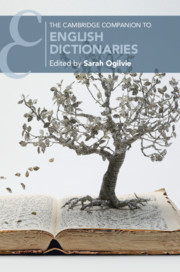Book contents
- The Cambridge Companion to English Dictionaries
- The Cambridge Companion to English Dictionaries
- Copyright page
- Dedication
- Contents
- Illustrations
- Tables
- Notes on Contributors
- Acknowledgements
- Chronology
- Chapter 1 Introduction
- Part I Issues in English Lexicography
- Part II English Dictionaries Throughout the Centuries
- Chapter 8 A Dictionary Ecosystem: Four Centuries of English Lexicography
- Seventeenth-Century English Dictionaries: Hard Words
- Eighteenth-Century English Dictionaries: Prescriptivism and Completeness
- Nineteenth-Century English Dictionaries: Descriptivism
- Twentieth and Twenty-First-Century Dictionaries
- Chapter 15 The English Period Dictionaries
- Chapter 16 English-as-a-Foreign-Language Lexicography
- Chapter 17 Electronic Dictionaries
- Chapter 18 English Dictionaries and Corpus Linguistics
- Chapter 19 Natural Language Processing in Lexicography
- Part III Dictionaries of English and Related Varieties
- Guide to Further Reading
- Index
- Cambridge Companions to Literature
Chapter 15 - The English Period Dictionaries
from Twentieth and Twenty-First-Century Dictionaries
Published online by Cambridge University Press: 18 September 2020
- The Cambridge Companion to English Dictionaries
- The Cambridge Companion to English Dictionaries
- Copyright page
- Dedication
- Contents
- Illustrations
- Tables
- Notes on Contributors
- Acknowledgements
- Chronology
- Chapter 1 Introduction
- Part I Issues in English Lexicography
- Part II English Dictionaries Throughout the Centuries
- Chapter 8 A Dictionary Ecosystem: Four Centuries of English Lexicography
- Seventeenth-Century English Dictionaries: Hard Words
- Eighteenth-Century English Dictionaries: Prescriptivism and Completeness
- Nineteenth-Century English Dictionaries: Descriptivism
- Twentieth and Twenty-First-Century Dictionaries
- Chapter 15 The English Period Dictionaries
- Chapter 16 English-as-a-Foreign-Language Lexicography
- Chapter 17 Electronic Dictionaries
- Chapter 18 English Dictionaries and Corpus Linguistics
- Chapter 19 Natural Language Processing in Lexicography
- Part III Dictionaries of English and Related Varieties
- Guide to Further Reading
- Index
- Cambridge Companions to Literature
Summary
This essay describes the histories of the Middle English Dictionary (MED, completed in 2001) and the Dictionary of Old English (DOE, still in progress), their editorial procedures, and how each one has dealt with the problems facing it. For the MED, those problems included how to reconcile the fairly reliable dates of the manuscripts with the usually conjectural composition dates in the dating of illustrative quotations; how to distinguish the chronological dimension from the synchronic dimension and at the same time to distinguish the geographical/regional dimension from the chronological; and how to balance the original conception of a bilingual translation dictionary with the need to define as accurately as possible. For the DOE, those problems included how to develop a comprehensive electronic corpus of Old English texts, as well as to maintain and renew it; how to mark up the digital DOE to capture its deeply embedded information so that both Anglo-Saxon language and culture are accessible; how to connect outward to other relevant digital resources to enlarge DOE’s interpretative environment; and finally, how to balance the writing of definitions without claiming more knowledge than exists for this early material.
Keywords
- Type
- Chapter
- Information
- The Cambridge Companion to English Dictionaries , pp. 183 - 194Publisher: Cambridge University PressPrint publication year: 2020

